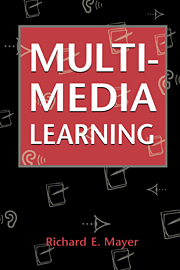Book contents
- Frontmatter
- Contents
- PREFACE
- 1 The Promise of Multimedia Learning
- 2 Multimedia Instructional Messages
- 3 A Cognitive Theory of Multimedia Learning
- 4 Multimedia Principle
- 5 Spatial Contiguity Principle
- 6 Temporal Contiguity Principle
- 7 Coherence Principle
- 8 Modality Principle
- 9 Redundancy Principle
- 10 Individual Differences Principle
- 11 Principles of Multimedia Design
- REFERENCES
- AUTHOR INDEX
- SUBJECT INDEX
11 - Principles of Multimedia Design
- Frontmatter
- Contents
- PREFACE
- 1 The Promise of Multimedia Learning
- 2 Multimedia Instructional Messages
- 3 A Cognitive Theory of Multimedia Learning
- 4 Multimedia Principle
- 5 Spatial Contiguity Principle
- 6 Temporal Contiguity Principle
- 7 Coherence Principle
- 8 Modality Principle
- 9 Redundancy Principle
- 10 Individual Differences Principle
- 11 Principles of Multimedia Design
- REFERENCES
- AUTHOR INDEX
- SUBJECT INDEX
Summary
This chapter summarizes seven principles of multimedia design: multimedia, spatial contiguity, temporal contiguity, coherence, modality, redundancy, and individual differences. It addresses five questions about multimedia design: Does multimedia work? When does multimedia work? For whom does multimedia work? How does multimedia work? What makes an effective multimedia presentation? Finally, the chapter closes with comments concerning the contributions and challenges of multimedia research.
SEVEN PRINCIPLES OF MULTIMEDIA DESIGN
My goal in writing this book was twofold: to improve our understanding of how people learn from words and pictures (that is, to contribute to a theory of multimedia learning) and to improve the design of multimedia presentations (that is, to contribute to the practice of multimedia instruction). On the theoretical side, I began with a cognitive theory of multimedia learning – as described in chapter 3 – that made specific predictions concerning seven kinds design effects. I tested the predicted design effects in a large series of experimental studies, involving measures of both transfer and retention. Overall, the results are highly consistent with the predictions of the cognitive theory of multimedia learning, lending support to our conception of how people integrate visual and verbal presentations (Mayer, 1997, 1999a, 1999b).
On the practical side, the results offer a set of seven basic principles for the design of multimedia presentations. Figure 11.1 defines each of the seven principles of multimedia design that I have presented in this book.
- Type
- Chapter
- Information
- Multimedia Learning , pp. 183 - 194Publisher: Cambridge University PressPrint publication year: 2001
- 1
- Cited by



